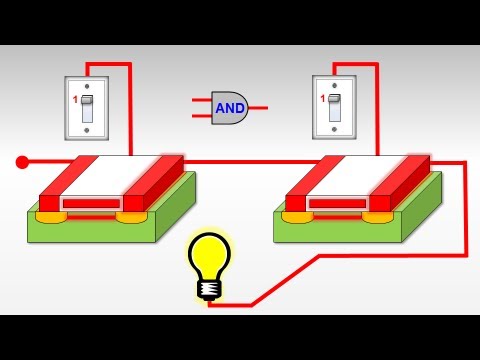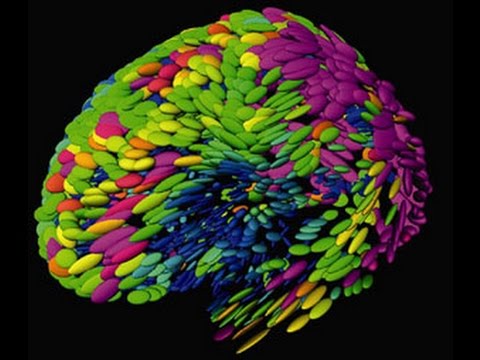In One Lesson
Take a look inside your computer to see how transistors work together in a microprocessor to add numbers using logic gates.
Get the book CODE that inspired the video http://amzn.to/pR9MwK
This is a great book by Charles Petzold that really breaks down a computer conceptually so that non-technical readers can understand how it works.
EDIT: At 00:12, the chip that is circled is not actually the CPU on this motherboard. This is an older motherboard where the CPU was first inserted into a small board and that board was then inserted into a slot on the motherboard. The chip that is circled is called the “northbridge” and helps the CPU communicate with memory. The northbridge also uses transistors and logic gates just like the CPU.
Source




unsigned int Add(unsigned int a,unsigned int b)
unsigned int c= a & b;
unsigned int r= a ^ b;
while(c!= 0)
{
unsigned int sc = c<< 1;
c=r≻
r^= sc;
}
return r;
}
}
carryValue:1 carryByte:00000001
resultValue:30 resultByte:00011110
shiftedcarryValue:2 shiftedcarryByte:00000010
carryValue:2 carryByte:00000010
resultValue:28 resultByte:00011100
shiftedcarryValue:4 shiftedcarryByte:00000100
carryValue:4 carryByte:00000100
resultValue:24 resultByte:00011000
shiftedcarryValue:8 shiftedcarryByte:00001000
carryValue:8 carryByte:00001000
resultValue:16 resultByte:00010000
shiftedcarryValue:16 shiftedcarryByte:00010000
carryValue:16 carryByte:00010000
resultValue:0 resultByte:00000000
shiftedcarryValue:32 shiftedcarryByte:00100000
resultValue:32 resultByte:00100000
something like that.
i got a lot of things from that video and thank you for your time
Best tutorial on how digital electronic system work!
I want to thank you for being a great Teacher and me not understanding anything you said .. Good-luck with your next video
salute you. i'm just thinking how he might have made such huge animation of bulbs. because first he has to learn every hell out of theses calculations then have to apply each one to right layer or slide, damn confusing.
This is a great video. Now I finally understand (80% maybe) how the logic works in a computer and what physical elements create this logic. It's still a far cry from actually "getting" the whole, but it's a really good start. Thanks for this video.
When was this all figured out? In the 1940's? Or was it even much earlier?
My favorite video!!! Thanks for sharing!!!
This covered 2 weeks of my Computer Architecture class in 14min 26sec, and I understand it better than I ever did in those two weeks. Thank you.
The video needs an edit. @That Guy, The author hasn't even figured it out yet, LMAO @0:14 he highlights that BX440 chipset with a heat sink on it, then refers to it as a "microprocessor". The processor of course having been removed prior to shooting that take (as indicated by the unpopulated slot 1 direct right of the chipset). I am 90% sure the motherboard is an ASUS P2B-F PII/III slot 1 motherboard. One of my favorites quite easy to shell that PII cartridge and jump some contacts to overclock it. I swapped oscillators cause even with a jumped cart you are still limited to a 5x multiplier(4.5 without jump). Still I had lots of low brow hack bragging rights when my PII 450 (605mhz on a 121mhz bus) would crank out Unreal Tournament GOTY on Dual, overclocked Voodoos rockin vblank 3rd party drivers. Faster than guys with brand new PIII 6-800 mhz cpus that cost 3x what I had in my rig…. "HEADSHOT!!" … lol good times.
I totally have nothing to say. Let me stick with history about Napoleon and world war. Helllll
I'm glad my programming teacher linked this video as part of our notes, this was so helpful!
Confusing description of a NAND gate, bruh.
my question is who operates the switches? in side computer switches gets operated by non moving method .. how a computer does that
are u on udemy? where do you sell the videos? Reading is slower than video, but good in combination.
Went from interested in the beginning because I understood it to you lost me. Video is just showing off and not teaching very well.
thank you very good explanation
Thank youuuuuu)))
My mom always told me not to be a half adder
That's a northbridge, not a CPU
As a mechanical engineer it took four times for me to understand this video.. However some 1% came into my mind but many questions arising.. Like how they manufacture this much tiny chips.. Now agreeing electronics engineers are the real gems.. Cheers
Absolutely AMAZING explanation!!!! Very clear and straightforward!!! Making the fundamentals of computing easy to understand so that the learner can have a firm grasp before going on to the more sophisticated computing!
thanks, gonna try this in minecraft with redstone
11:35
Atlast it is clear to me how transistor do calculations. Hats off to the humans who created these logic gates.
OK, I'm only 30 seconds in and I paused multiple times before I laughed out loud! 1) Why is the motherboard shown in a mirrored image? I immediately recognized that as a typical Pentium II / III era 440BX chipset motherboard, basically identical to the Asus motherboard I got with my early Pentium III system. 2) The northbridge chipset is circled and incorrectly identified as "the microprocessor." The processor for those early P3s used a cartridge design, which went into the big empty black slot ("slot 1") you see on the board. My twin brother insists that the video is trolling, but I don't think so. OK, I'll finish watching the video now 🙂
im done watching this view after 14 seconds the pointed to the north bridge chip set on slot 1 motherboard and called it a cpu
I understood 101% of he said.
That's not the cpu you circled in the opening. That is an old mb that takes a 'cartridge' cpu that comes on it's own small pcb with cache and such on it and goes into that big slot screen right of the green heatsink.
At 8:54 he makes a mistake by saying that the or gate is off and the nand gate is on , actually the or gate is on and the nand gate is off.